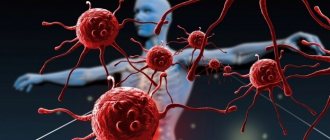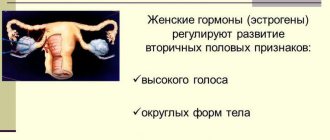pharmachologic effect
Estradiol, the active substance in Estrofem, is similar to the hormone estrogen, which is produced by women's ovaries. The drug promotes the normal development of the external and internal genital organs of the female body - fallopian tubes, uterus, vagina, milk ducts, and has a positive effect on nipple pigmentation.
Estrofem normalizes the menstrual cycle and the emotional state of a woman, regulates fat, protein and carbohydrate metabolism, and increases libido. The drug strengthens the skeletal system and prevents the development of osteoporosis.
Estrofem
Orally, without chewing, with a small amount of liquid, 2 mg/day, for 21 days, followed by a break for 7 days, after which treatment is continued. The duration of treatment is up to 6 months, after which an examination is carried out to decide whether it is advisable to continue estrogen replacement therapy. In women with a uterus removed or in menopausal women, treatment with the drug can be started on any day. If the menstrual cycle is preserved, the first tablet should be taken on the 5th day of the cycle (1st day of the cycle = 1st day of menstruation).
IM, in the form of a 0.1% solution in oil: for primary amenorrhea with underdevelopment of the genital organs and secondary sexual characteristics - 1-2 mg daily or every other day for 1-2 months or more, until palpable enlargement of the uterus; after this - progesterone intramuscularly, 5 mg daily for 6-8 days. If necessary, repeat courses of hormone therapy are carried out. For secondary amenorrhea - 1 mg daily for 15-16 days, followed by progesterone or pregnin for 6-8 days. If there is no persistent clinical effect, the course of treatment is repeated. For hypo- and oligomenorrhea, dysmenorrhea, infertility due to ovarian hypofunction and underdevelopment of the uterus - 0.5-1 mg for 15-16 days after the end of menstruation and then, if indicated, progesterone or pregnin for 6-8 days. The course of treatment can be repeated several times at the same time, after the end of menstruation. For pathological phenomena associated with the onset of menopause and surgical removal of the ovaries - 0.5-1 mg daily or every 1-2 days, in courses of 10-15 injections. If symptoms return, the course of treatment is repeated. Doses should be selected strictly individually depending on the phase of menopause and the severity of the disease. In case of weakness of labor and post-term pregnancy - intramuscularly, 4-5 mg 2-3 hours before the introduction of birth-stimulating drugs. As a hemostimulating drug, when the number of leukocytes decreases below 2 thousand/μl of blood (usually from 10-20 days after irradiation for severe lesions and from 15-18 days for milder lesions) - 1 mg every 1-2 days. The course of treatment is 10 injections (if necessary - up to 15 injections).
TTS is attached to a clean, dry and intact area of body skin (lumbar region, abdomen) 2 times a week. Treatment begins with TTC 50 mcg, followed by individual dose selection (the appearance of a feeling of tension in the mammary gland or intermediate bleeding is a sign of an increased dosage that needs to be reduced). If after 2-3 weeks the signs and symptoms of estrogen deficiency do not stop, the dose should be increased. TTC is applied cyclically: after 3 weeks of treatment (6 applications) - an interval of 7 days, during which metrorrhagia is possible. Continuous, non-cyclic therapy is indicated for women following a hysterectomy or in cases where symptoms of estrogen deficiency become severe again during the 7-day interval. Subsequent therapy with gestagens should be carried out according to the following scheme: with continuous use of TTC, it is recommended to additionally prescribe a gestagen (10 mg medroxyprogesterone acetate, 5 mg norethisterone, 5 mg norethisterone acetate or 20 mg dydrogesterone in the first 10-12 days of each month). When using TTC cyclically, it is recommended to additionally take gestagen in the last 10-12 days of therapy so that the fourth week of each cycle remains free from therapy with any hormone. In both cases, after the end of 10-12 days of gestagen therapy, bleeding occurs.
The gel is used once a day, in the morning or evening, 1.5 mg (2.5 g of gel or 1-2 doses) - applied in a thin layer to clean skin of the abdomen, lumbar region, shoulders and forearms. The application area should be equal in size to 1-2 palms. The gel should be absorbed in less than 2-3 minutes. If it remains on the surface of the skin for more than 5 minutes, then the drug was applied to too small a surface of the skin. The gel is prescribed continuously or in cycles. Doses and duration of therapy are determined individually.
Contraindications
- Breast cancer or suspicion of it, and previous breast cancer;
- endometrial cancer;
- vaginal bleeding of unknown etiology;
- untreated endometrial hyperplasia;
- thrombophlebitis, thrombosis, pulmonary embolism;
- angina pectoris, myocardial infarction;
- acute liver diseases;
- hypersensitivity to the components of the drug;
- porphyria;
- pregnancy and lactation.
Use with caution to treat women over 65 years of age.
Indications for use Estrofema
The instructions for Estrofem recommend the drug for use in the following cases:
- with estrogen deficiency during menopause and with surgical menopause caused by non-malignant neoplasms, following radiation castration;
- with amenorrhea of primary and secondary type;
- for hypomenorrhea, dysmenorrhea, oligomenorrhea and secondary estrogen deficiency;
- with hirsutism against the background of the formation of multiple ovarian cysts;
- with vaginitis (in young and old ages);
- with hypogenitalism;
- for infertility;
- with weak labor;
- in case of post-term pregnancy;
- with virile hypertrichosis in women;
- to suppress lactation;
- with postmenopausal osteoporosis;
- for breast or prostate cancer;
- for urogenital disorders (including atrophic vulvovaginitis, trigonitis, dyspareunia (painful sexual intercourse), urethritis);
- with alopecia due to hyperandrogenemia;
- as a means that can stimulate hematopoiesis in men who have suffered acute radiation injury.
Compatibility with other drugs
Preparations of male hormones, as well as hypoglycemic, anticoagulant, and antihypertensive drugs have a weaker effect when used simultaneously with Estrofem.
Estradiol is absorbed more intensively when taken simultaneously with anesthesia drugs, barbiturates, antiepileptic drugs, analgesics, and liver enzymes.
Taking phenylbutazone, rifampicin and ampicillin and changing the intestinal flora reduces the absorption of Estrofem.
The therapeutic effect of estradiol is enhanced by folic acid and synthetic thyroid hormones.
special instructions
Estrofem does not have a contraceptive effect and is not able to protect against pregnancy.
Medical reviews of Estrofem note the drug’s ability to have a protective effect on the endometrium when taken together with progestogens for at least 10 days during each cycle.
The appearance of unusual or irregular menstrual discharge during the use of Estrofem requires a diagnostic curettage, which would exclude the presence of malignant neoplasms in the uterine area.
In case of long-term use of Estrofem, it is recommended to undergo preventive examinations at least once a year.
It is important to keep in mind that long-term use of Estrofem alone (monotherapy) increases the risk of developing endometrial cancer if the uterus is not removed.
Patients suffering from migraine, epilepsy, bronchial asthma and diabetes mellitus, as well as those taking antihypertensive drugs, are recommended to have medical supervision throughout the course of taking Estrofem.
It is recommended to discontinue treatment if deep vein thrombosis occurs, with the appearance of jaundice, thromboembolic disorders, sudden visual disturbances, a marked increase in blood pressure, as well as before planned surgical operations (4-6 weeks before them).
Directions for use and doses
The method of administration and dosage regimen of a particular drug depend on its release form and other factors. The optimal dosage regimen is determined by the doctor. The compliance of the dosage form of a particular drug with the indications for use and dosage regimen should be strictly observed.
Individual, depending on the indications and dosage form used.
Treatment with estradiol is supplemented with progestin drugs for at least 10 days (once every 1-3 months).
Pharmacodynamics and pharmacokinetics of the drug
The synthetic estradiol contained in the drug is as close as possible to the natural female hormone produced in the ovaries. Its action in the body eliminates estrogen deficiency and prevents the process of decreased bone mineralization (during postmenopause).
When HRT (hormone replacement therapy) is prescribed in the form of Estrofem, bone density increases, which prevents osteoporosis and reduces the risk of bone fractures (including the spine or hip joints).
After administration, the medicine is quickly absorbed in the stomach, exposed to digestive enzymes. After 6 hours, the body reaches its maximum concentration of estradiol. Target organs accumulate this hormone and contribute to the formation of active and inactive compounds.
Elimination of estradiol occurs in the kidneys and intestines (after combining with bile).
Reviews from women
Lyudmila, 50 years old : “I had surgery to remove very large uterine fibroids. The ovaries were also removed. The symptoms of menopause were very noticeable, so Estrofem hormonal tablets were immediately prescribed. I tolerated them well. I didn’t feel sick and didn’t have a headache either. I still accept them now.”
Diana, 42 years old : “I took the drug Estrofem about 7 years ago to get pregnant. The regimen was selected by my gynecologist and combined with other medications. We couldn't do anything on our own. That's why we decided to undergo IVF. Now my son is 5 years old.”
Larisa, 56 years old : “Quite recently I started to suffer from hot flashes. I don’t sleep well at night, and I lash out at others all day. At a doctor’s appointment after preliminary examinations, he prescribed me hormonal tablets Estrofem. I completed a 6-month course of treatment and now almost nothing bothers me. I combined them with progestogen.”
Drug interactions
Combination with the following medications reduces the effectiveness of Estrofem hormonal tablets:
- Anticonvulsants.
- Anxiolytics.
- Barbiturates.
- Enzyme inducers.
- Opioid analgesics.
- Antibiotics.
- St. John's wort.
The drug Estrofem in the form of hormonal tablets helps to reduce the therapeutic effect of diuretics, drugs that lower blood sugar, hypotensive agents, male sex hormones, and anticoagulants.
Recommended viewing:
Analogs
Analogues of Estrofem are preparations containing estradiol. These medications are:
- Klimara;
- Proginova;
- Estrimax;
- Mirena.
Estrofem is used by various groups of women. It is especially often used during IVF and in the postmenopausal period. In general, Estrofem is well tolerated and is often taken for longer than 6 months. However, vigilance when taking this medication and strict adherence to the instructions are extremely important. Otherwise, instead of benefit, you can cause irreparable harm to your health.
Instructions for use
The daily dose cannot exceed one hormonal tablet Estrofem.
After taking 21 tablets, you should take a 7-day break for the onset of your period.
After a week of “rest”, start a new package.
The duration of therapy with the drug Estrofem most often lasts at least six months .
Compound
Active component: 17β-estradiol (17β-Oestradiolum) is a biological and chemical analogue of endogenous 17β-estradiol, produced by the female body from the beginning of the first menstruation.
Formula of the female sex hormone estradiol
Auxiliary components: lactose monohydrate, corn starch, gelatin, talc, magnesium stearate, hypromellose.
Dyes: blue paste consisting of indigo carmine (E132) and macrogol, and titanium dioxide (E171).
Dosage form
Estrofem is produced in the form of round biconvex blue tablets with a film coating. On one side is stamped “NOVO 280”. One tablet contains 2 mg estradiol (as 2.07 mg extradiol hemihydrate).
Pharmacotherapeutic group
Estrogens, gestagens, their homologues and antagonists.
ATX code: G03CA03.
The importance of estradiol drugs during pregnancy
What are the important functions of estradiol after pregnancy?
After IVF, a woman is repeatedly subjected to various tests to determine her hormonal levels.
The estradiol level after successful IVF should be within the range of 5-10,000 pmol/l. A level below this figure is threatening and is compensated by the artificial administration of estradiol drugs. It is to this group that Estrofem belongs.
The main consequence of a lack of estradiol after any pregnancy is insufficient thickness of the endometrium. This condition of the endometrium does not allow the embryo to attach normally to the uterus, which will threaten its pregnancy.
The functions of estradiol in the body of a pregnant woman are also indicated:
- maintaining normal blood circulation in the uterus;
- preparing the uterine tissues for normal childbirth by ensuring their stretching;
- smooth functioning of the fetoplacental system;
- complete supply of nutrients to the embryo and the formation of its skeleton.
After the long-awaited IVF, along with Estrofem, a woman can be prescribed hormonal medications containing estradiol in the form of:
- Proginova tablets;
- external gels: Estrogel, Divigel.







